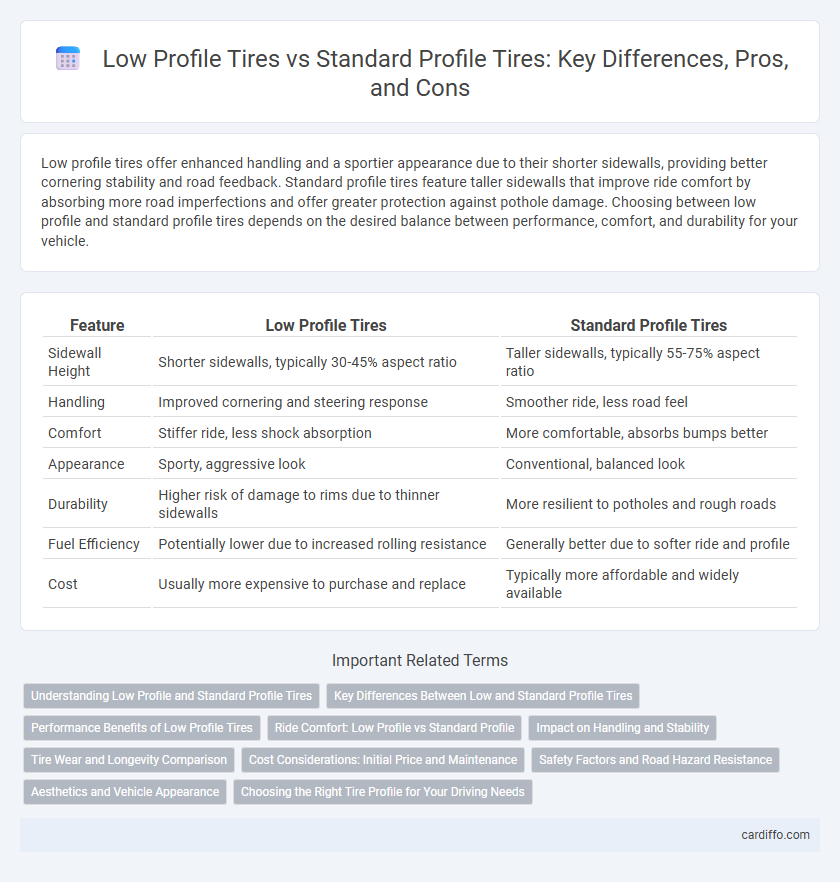Low profile tires offer enhanced handling and a sportier appearance due to their shorter sidewalls, providing better cornering stability and road feedback. Standard profile tires feature taller sidewalls that improve ride comfort by absorbing more road imperfections and offer greater protection against pothole damage. Choosing between low profile and standard profile tires depends on the desired balance between performance, comfort, and durability for your vehicle.
Table of Comparison
| Feature | Low Profile Tires | Standard Profile Tires |
|---|---|---|
| Sidewall Height | Shorter sidewalls, typically 30-45% aspect ratio | Taller sidewalls, typically 55-75% aspect ratio |
| Handling | Improved cornering and steering response | Smoother ride, less road feel |
| Comfort | Stiffer ride, less shock absorption | More comfortable, absorbs bumps better |
| Appearance | Sporty, aggressive look | Conventional, balanced look |
| Durability | Higher risk of damage to rims due to thinner sidewalls | More resilient to potholes and rough roads |
| Fuel Efficiency | Potentially lower due to increased rolling resistance | Generally better due to softer ride and profile |
| Cost | Usually more expensive to purchase and replace | Typically more affordable and widely available |
Understanding Low Profile and Standard Profile Tires
Low profile tires feature shorter sidewalls and wider treads compared to standard profile tires, enhancing handling and cornering performance by reducing sidewall flex. Standard profile tires provide a taller sidewall, offering a more comfortable ride and better shock absorption on rough roads due to increased cushioning. Understanding the differences in sidewall height and tread width helps drivers choose tires that balance comfort, performance, and vehicle aesthetics.
Key Differences Between Low and Standard Profile Tires
Low profile tires feature shorter sidewalls that enhance handling and cornering precision by reducing flex, while standard profile tires offer more cushioning for a smoother ride and improved comfort on rough roads. The reduced sidewall height in low profile tires increases road contact and steering response but may result in a harsher ride and higher risk of damage from potholes compared to standard profile tires with taller sidewalls. Choosing between low and standard profile tires depends on prioritizing performance and aesthetics versus ride comfort and durability in driving conditions.
Performance Benefits of Low Profile Tires
Low profile tires offer enhanced handling and cornering stability due to their shorter sidewalls, which reduce flex during aggressive driving. These tires provide improved steering response and better road grip on dry surfaces, making them ideal for performance-oriented vehicles. However, they may deliver a firmer ride and increased road noise compared to standard profile tires.
Ride Comfort: Low Profile vs Standard Profile
Low profile tires typically offer enhanced cornering and handling performance due to their stiffer sidewalls but often result in a firmer ride and reduced absorption of road imperfections. Standard profile tires feature taller sidewalls that provide better cushioning and improved ride comfort on rough or uneven surfaces. Choosing between low profile and standard profile tires involves balancing handling precision against ride softness depending on driving preferences.
Impact on Handling and Stability
Low profile tires offer improved handling and stability due to their shorter sidewalls, which reduce flex during cornering and provide better road grip. Standard profile tires have taller sidewalls that absorb shocks better but can result in less precise steering response and increased body roll. Drivers prioritizing sharp handling often choose low profile tires, while those valuing ride comfort may prefer standard profile options.
Tire Wear and Longevity Comparison
Low profile tires typically exhibit faster wear compared to standard profile tires due to reduced sidewall height and stiffer rubber compounds, which increase road contact and heat generation. Standard profile tires generally offer enhanced longevity with deeper tread depths and more flexible sidewalls, absorbing road impacts better and reducing uneven wear. Tire wear patterns in low profile tires can also lead to premature replacement, while standard profile tires often maintain tread integrity over longer distances, resulting in cost-effective maintenance.
Cost Considerations: Initial Price and Maintenance
Low profile tires generally have a higher initial price compared to standard profile tires due to their specialized construction and enhanced performance features. Maintenance costs also tend to be greater for low profile tires, as they are more susceptible to damage from potholes and uneven road surfaces, leading to more frequent repairs or replacements. Standard profile tires offer a more cost-effective option with lower upfront expenses and reduced risk of damage, making them a budget-friendly choice for everyday driving.
Safety Factors and Road Hazard Resistance
Low profile tires offer enhanced steering responsiveness and improved cornering stability due to their shorter sidewalls, but they tend to have reduced shock absorption, increasing susceptibility to road hazards such as potholes and curbs. Standard profile tires feature taller sidewalls that provide better cushioning, enhancing safety by absorbing impacts and reducing the risk of tire damage or blowouts on rough surfaces. The choice between low profile and standard profile tires impacts overall road hazard resistance and vehicle safety, with standard profiles generally offering greater protection in adverse driving conditions.
Aesthetics and Vehicle Appearance
Low profile tires enhance vehicle aesthetics by providing a sportier, more aggressive stance with a larger wheel-to-tire ratio, making rims more prominent. Standard profile tires offer a balanced look with thicker sidewalls, preserving a classic appearance and often complementing traditional vehicle designs. The choice between low and standard profiles significantly impacts the visual appeal, influencing the overall impression and style of the vehicle.
Choosing the Right Tire Profile for Your Driving Needs
Low profile tires feature shorter sidewalls that improve handling and cornering performance, making them ideal for sports cars and aggressive driving. Standard profile tires offer more cushioning and better ride comfort, suitable for daily commuting and rough road conditions. Selecting the right tire profile depends on your vehicle type, driving habits, and road conditions to balance performance, comfort, and durability.
Low profile tires vs standard profile tires Infographic

 cardiffo.com
cardiffo.com